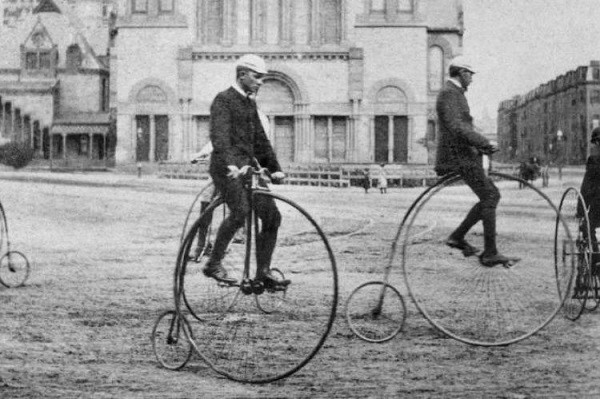Japan is considered a cyclist’s paradise. It’s a country where being a bicycle rider is cooler than being a motorist. Here you won’t be startled by the mocking horn of a passing car, you won’t get splashed with muddy water from under car wheels, and motorists will drag behind you obediently as you ride down the narrow road. Japanese bicycles are some of the most popular and common vehicles in the Land of the Rising Sun. Let’s talk about how the bicycle industry has evolved in Japan and its most popular bike models.
History of Japanese bicycles
History has not preserved information on exactly what day the first bicycle appeared in Japan. Based on articles in newspapers and magazines, it happened around the 60s. 19 century. It was a period of active exploration of the new Asian market by European and American goods.

Penny Farthing
The British Penny Farthing was the most common two-wheeler at that time. It had a characteristic feature: large front wheels and much smaller rear wheels. Because of this design, the bicycle was quite difficult to master. It was extremely unstable and difficult to control. The Japanese did not complicate their lives and began to actively use three-wheeled bicycles, which were much more convenient and cheaper. Moreover, on such models it was possible to transport bulky cargo and goods from one point to another.
Given that the demand for bicycles was growing every year, small forge shops began to appear in the country, which launched their own production of two-wheeled transport. European and American examples were taken as the basis, but each bike was made to an individual order.
At the end of the 19th century, Japanese bikes were considered the cheapest. For example, if the price of American models in the U.S. started at $50 per bike, the Japanese model sold for an average of $ 12, and they were not inferior in quality to American.
Prior to World War II, Japan had firmly gained a leading position in the world market, selling more than two million bikes annually in their country and around the world.
After the defeat in the war, Japanese cities and factories lay in ruins, everything had to start from scratch. For more than a quarter of a century there were hard times in the development of not only the bicycle industry, but also the rest of the country’s industry. Japanese manufacturers for a long time made the same mistake: producing models of bicycles for export, not designed for the technical characteristics of the larger than Japanese Europeans and Americans. The Japanese bicycles were as good as the European models, and in many ways superior, but were too fragile for overseas consumers.
Eventually, American dealers were able to convince manufacturers in the Land of the Rising Sun that the bikes they produced needed to be adapted for European and American riders. From that moment, a new round of successful conquest of foreign markets by Japanese bicycle industry products began.
In the 80’s with the development of bicycle tourism sales platforms actively filled with touring bikes, but it quickly became clear that they are too much trouble – these bikes are not available in finished form, it was necessary to buy another type of bike and modernize it by installing additional equipment. Then the production of stock tourers was started and many well-known Japanese companies began to supply these bikes in huge quantities.
Later, touring bikes were replaced by a new trend: mountain bikes. All was well until a new problem appeared – the collapse of the dollar exchange rate by more than 2 times, which led to the bankruptcy of many manufacturers.
Development of the Bicycle Industry in Japan Today
With the collapse of the dollar Japanese bikes were no longer profitable to produce for export-they became too expensive for foreign consumers. That is why many bicycle brands ceased to exist, while others found a way out by buying cheaper parts in Taiwan.
It is now quite rare to find a bicycle made in Japan, although this does not mean that the bicycle industry in that country is dead. About 1,500 large companies and small family businesses are still involved in the business. They produce not only finished bikes, but also accessories and parts for them. Japan’s domestic market actively absorbs large volumes of bicycle products, which allows local manufacturers to stay afloat.
Almost everyone in Japan rides a bicycle: housewives, students, office workers, police officers, businessmen, and members of the imperial family. Japan ranks 1st among Asian countries by the number of bicycles per 100 people. In the Greater Tokyo, a city of 40 million people, there are 74 bicycles for every 100 residents. The smallest number of people ride bikes is on Okinawa Island, where “only” one in four residents owns a two-wheeled iron steed.
Popular Japanese bike brands
Japanese bicycle models are often chosen according to age and occupation, for example: younger riders prefer mountain bikes, office workers – folding. But the most popular bicycle is the Japanese city-bike, or mama-chari, a heavy steel construction with baskets. This is ideal for moms who have to transport not only their children through the streets of the city, but also provisions.
As for brands of bicycles from Japanese manufacturers, among them there are very decent and world-renowned brands.
Kuwahara .
The company, which made its first steps in the production of bicycles and bicycle parts back in 1918 in the city of Osaka. Particular success has been achieved in the production of BMX class bikes. But the brand received international recognition and fame thanks to the appearance of a bike KZ-1 with a solid, lightweight frame and improved geometry in the famous Steven Spielberg movie E.T.. (“E.T.”). In the wake of the film’s success, the company was not confused and began producing red and white “ET” models, which are still in production today.
Miyata
The company began its work in 1890. At that time it was a small armory, which was engaged in the production of weapons for the Imperial Army. In the beginning, bicycle repair was a secondary business, later the company began to produce its own bikes. The highlight was the decision to use rifle barrels for bicycle frames, which the company itself produced.
There is a strong belief that it was Miyata’s founder who pioneered the triple-barrel technology, and his engineers revolutionized the frame assembly technique.
Over time, Miyata became one of the main Japanese manufacturers, exporting bicycles to other countries. Not only bikes were produced from the factories under its own name, the company produced bikes for many other well-known brands. But today the company has lost its popularity and its models are rarely seen outside Japan, while it still finds its admirers in Western Europe.
Shimano
Few cyclists, even beginners, do not know about the products of this company. Japan’s Shimano is one of the largest in the world of the bicycle industry. It accounts for about half of the global cycling equipment market. And it is not surprising, because it is considered the main supplier of components for mountain and road bikes(gears, brakes, stars, flywheels, etc.). Its position as a manufacturer of bicycle components for road, track and hybrid bikes is also strong. Products of this brand bring victories to the best cyclists in the world.
The company was founded in 1921, in a room of 40 square meters. Initially, it was positioned as a supplier of individual bicycle components. Production grew steadily and new employees were hired. After World War II, Shimano fairly quickly regained its position and capital by launching the production of complete bicycles. Constantly inventing new components, using technological innovations and selling its products at more attractive prices than competitors, the company gradually displaced European brands in the global market.
Unlike many conservative Japanese manufacturers, Shimano studied the preferences of people in the U.S. and Europe to create lines for a variety of consumer groups.
Shimano always follows the principle of continuous development, inventing new accessories for bikes and improving the previous series – this position is the eternal key to the success of the company, not only among professional athletes, but also with ordinary fans of biking.
Yamaha
It is a world-known Japanese manufacturer, which produces not only products for bicycles, but also motor vehicles, boats and boat motors, sound equipment, sports equipment, boats and snowmobiles, musical instruments and much more. The history of this company deserves a separate article and demonstrates painstaking work and persistence of its organizers. Yamaha is the world’s first manufacturer of E-BIKE – electric bicycles. These vehicles are now extremely popular and actively marketed around the world.
Fuji
The company was founded in the last year of the 19th century. Initially it imported to Japan and subsequently sold American bicycles, but later launched its own production. It was this company that organized Japan’s first national multi-day bicycle race in the 1930s. 20th century. Not surprisingly, the sponsor of the winning team of the race was Fuji.
In the mid-20th century, the company began selling its bicycles in the U.S., and sales were expanding to other Asian markets.
In the 70s. Fuji took advantage of the general bike boom and filled the market with touring and road bikes. It pioneered the production of titanium bike frames.
However, already in the 80s the company missed the chance to take advantage of the next boom, now for mountain bikes. The increased popularity of these bikes has sharply reduced sales of road and touring bikes. That’s when the decline of Fuji began. To date, Fuji brand belongs to a private American corporation Advanced Sports International (ASI). Bikes of this brand are produced in factories in Taiwan, China and Poland.
Panasonic
Well-known corporation, engaged not only in the production of consumer electronics and other electronic products, but also bicycles. Very few people know that after the Second World War and up to 1980 excellent city bikes and road bikes were produced under this brand. The most interesting thing: from the late 60s to the mid-80s, Panasonic was the leader among Japanese exporters who supplied their products to the United States.
Today, Panasonic hasn’t stopped making bikes and has a variety of product lines for a variety of consumer groups: road bikes, folding bikes, mountain bikes, city bikes, etc.
Ides
The company produces high-quality bicycles for children and teenagers. In Japan, the brand is the leader in sales of children’s bikes. Colorful and high-quality products of Ides company is also supplied to other countries of the world. The philosophy of this brand is based on the absolute safety of the child who became the owner of the bicycle.
Conclusion
Japanese bicycles are, for the most part, reliable and quality vehicles, which are not widespread enough outside the domestic market. And the reason is the excessive conservatism of manufacturing companies unwilling to be more flexible and change long-standing business models. We would like to believe that with time this trend will come to an end and we will be able to enjoy the unsurpassed quality of Japanese bikes on the roads and trails of our country.










Some brands of bicycles I had never even heard of, as it turns out I also have a Japanese bike at home! And I want to say that the quality of workmanship is excellent. I’ve had it for over two years now and it hasn’t broken down at all!